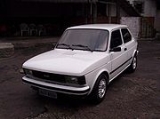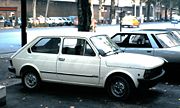
Fiat 147
Encyclopedia
The Fiat 147 was a three door hatchback
compact car produced by Fiat
in the Brazilian state of Minas Gerais
from 1976 until 1986, when it was replaced by the Fiat
Uno
. It was the Brazil
ian variant of the Fiat 127
. Some were also built by Sevel
in Argentina
(where later models were named Fiat Spazio, Brío and Vivace) until 1996, and Colombia
.
. Press reports of the time reported that the larger engine produced a much smoother and quieter drive as well an enhanced torque.
 The 147 was the first Brazilian car that used ethanol as fuel instead of petrol. The performance slightly increased and fuel consumption was 30% higher but the cost of the alcohol was a quarter of the gasoline because, at that time, petrol had become expensive as a consequence of the 1973 oil crisis
The 147 was the first Brazilian car that used ethanol as fuel instead of petrol. The performance slightly increased and fuel consumption was 30% higher but the cost of the alcohol was a quarter of the gasoline because, at that time, petrol had become expensive as a consequence of the 1973 oil crisis
. This version was nicknamed "cachacinha" (little cachaça
) because it had the smell of that drink.
and an estate called the Fiat Panorama
, both built in the 1980s. There were also van and pick-up versions.
, plus 232,807 units in the Sevel
plant of Córdoba
. This car was also assembled in the CCA plant in Bogotá
, Colombia.
A few Fiat 147s were exported to Italy. They are most easily differentiated from Italian-built Fiat 127
s (and the corresponding Spanish-built Seat 127) by the extractor vents in the rear three-quarter pillar.
Hatchback
A Hatchback is a car body style incorporating a shared passenger and cargo volume, with rearmost accessibility via a rear third or fifth door, typically a top-hinged liftgate—and features such as fold-down rear seats to enable flexibility within the shared passenger/cargo volume. As a two-box...
compact car produced by Fiat
Fiat
FIAT, an acronym for Fabbrica Italiana Automobili Torino , is an Italian automobile manufacturer, engine manufacturer, financial, and industrial group based in Turin in the Italian region of Piedmont. Fiat was founded in 1899 by a group of investors including Giovanni Agnelli...
in the Brazilian state of Minas Gerais
Minas Gerais
Minas Gerais is one of the 26 states of Brazil, of which it is the second most populous, the third richest, and the fourth largest in area. Minas Gerais is the Brazilian state with the largest number of Presidents of Brazil, the current one, Dilma Rousseff, being one of them. The capital is the...
from 1976 until 1986, when it was replaced by the Fiat
Fiat
FIAT, an acronym for Fabbrica Italiana Automobili Torino , is an Italian automobile manufacturer, engine manufacturer, financial, and industrial group based in Turin in the Italian region of Piedmont. Fiat was founded in 1899 by a group of investors including Giovanni Agnelli...
Uno
Fiat Uno
The Fiat Uno is a supermini car produced by the Italian manufacturer Fiat. The Uno was launched in 1983 and built in its homeland until 1995, with production still taking place in other countries.-First series :...
. It was the Brazil
Brazil
Brazil , officially the Federative Republic of Brazil , is the largest country in South America. It is the world's fifth largest country, both by geographical area and by population with over 192 million people...
ian variant of the Fiat 127
Fiat 127
The Fiat 127 is a supermini produced by the Italian automaker Fiat between 1971 and 1983. It was introduced in 1971 as the replacement for the Fiat 850...
. Some were also built by Sevel
Sevel Argentina S.A.
Sevel Argentina was an automobile company that produced and marketed Fiat, Peugeot, Alfa Romeo, Chevrolet, and Citroën automobiles for the Argentinian market until it was dissolved in 1999...
in Argentina
Argentina
Argentina , officially the Argentine Republic , is the second largest country in South America by land area, after Brazil. It is constituted as a federation of 23 provinces and an autonomous city, Buenos Aires...
(where later models were named Fiat Spazio, Brío and Vivace) until 1996, and Colombia
Colombia
Colombia, officially the Republic of Colombia , is a unitary constitutional republic comprising thirty-two departments. The country is located in northwestern South America, bordered to the east by Venezuela and Brazil; to the south by Ecuador and Peru; to the north by the Caribbean Sea; to the...
.
Fuel
During the two decades that followed the Second World War the available fuels in Europe had featured progressively higher octane ratings, and compression ratios of European cars had increased correspondingly. However, the cheaper (so called yellow grade) petrol widely distributed in Brazil in 1976 had an octane rating of just 73 octane, so for Brazil it was necessary to use a relatively low compression ratio of 7.2 to 1. In order to provide adequate power with the lower compression ratio, a larger engine was needed, and the Fiat 147 was launched with a 1049 cc unit with a five bearing crankshaft in place of the 903 cc three bearing engine that then was still standard in the 127s from TurinTurin
Turin is a city and major business and cultural centre in northern Italy, capital of the Piedmont region, located mainly on the left bank of the Po River and surrounded by the Alpine arch. The population of the city proper is 909,193 while the population of the urban area is estimated by Eurostat...
. Press reports of the time reported that the larger engine produced a much smoother and quieter drive as well an enhanced torque.

1973 oil crisis
The 1973 oil crisis started in October 1973, when the members of Organization of Arab Petroleum Exporting Countries or the OAPEC proclaimed an oil embargo. This was "in response to the U.S. decision to re-supply the Israeli military" during the Yom Kippur war. It lasted until March 1974. With the...
. This version was nicknamed "cachacinha" (little cachaça
Cachaça
Cachaça is a liquor made from fermented sugarcane.It is the most popular distilled alcoholic beverage in Brazil. It is also known as aguardente, pinga, caninha and many other names...
) because it had the smell of that drink.
Derivatives
Based on the Fiat 147 was a saloon called the Fiat OggiFiat Oggi
The Fiat Oggi is a two-door sedan based on the Fiat 147, a subcompact car produced in South America by Italian automaker Fiat. The Oggi was produced in Brazil from 1983 until 1985, when it was replaced by the Uno-based Prêmio...
and an estate called the Fiat Panorama
Fiat Panorama
The Fiat Panorama is a two-door station wagon version of the Fiat 147, a subcompact car produced in South America by Italian automaker Fiat. The Panorama was built in Brazil and released in March 1980 as one of the first small station wagons to be produced there...
, both built in the 1980s. There were also van and pick-up versions.
Production and markets
A total of 1,269,312 units were produced in Fiat's Brazilian factory in BetimBetim
Betim is a city in Minas Gerais, Brazil. It is located at around . The city belongs to the mesoregion Metropolitan of Belo Horizonte and to the microregion of Belo Horizonte....
, plus 232,807 units in the Sevel
Sevel Argentina S.A.
Sevel Argentina was an automobile company that produced and marketed Fiat, Peugeot, Alfa Romeo, Chevrolet, and Citroën automobiles for the Argentinian market until it was dissolved in 1999...
plant of Córdoba
Córdoba, Argentina
Córdoba is a city located near the geographical center of Argentina, in the foothills of the Sierras Chicas on the Suquía River, about northwest of Buenos Aires. It is the capital of Córdoba Province. Córdoba is the second-largest city in Argentina after the federal capital Buenos Aires, with...
. This car was also assembled in the CCA plant in Bogotá
Bogotá
Bogotá, Distrito Capital , from 1991 to 2000 called Santa Fé de Bogotá, is the capital, and largest city, of Colombia. It is also designated by the national constitution as the capital of the department of Cundinamarca, even though the city of Bogotá now comprises an independent Capital district...
, Colombia.
A few Fiat 147s were exported to Italy. They are most easily differentiated from Italian-built Fiat 127
Fiat 127
The Fiat 127 is a supermini produced by the Italian automaker Fiat between 1971 and 1983. It was introduced in 1971 as the replacement for the Fiat 850...
s (and the corresponding Spanish-built Seat 127) by the extractor vents in the rear three-quarter pillar.

